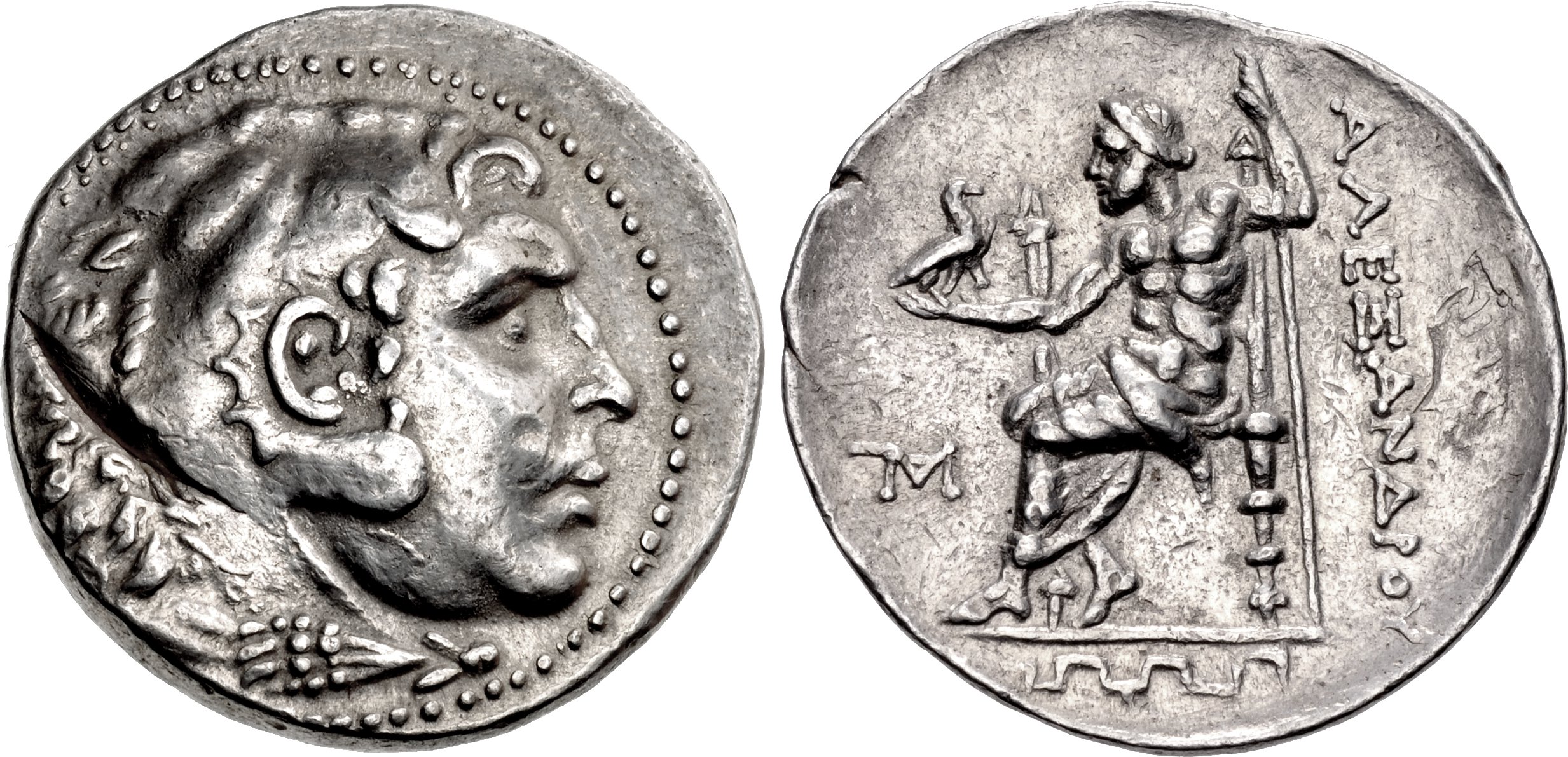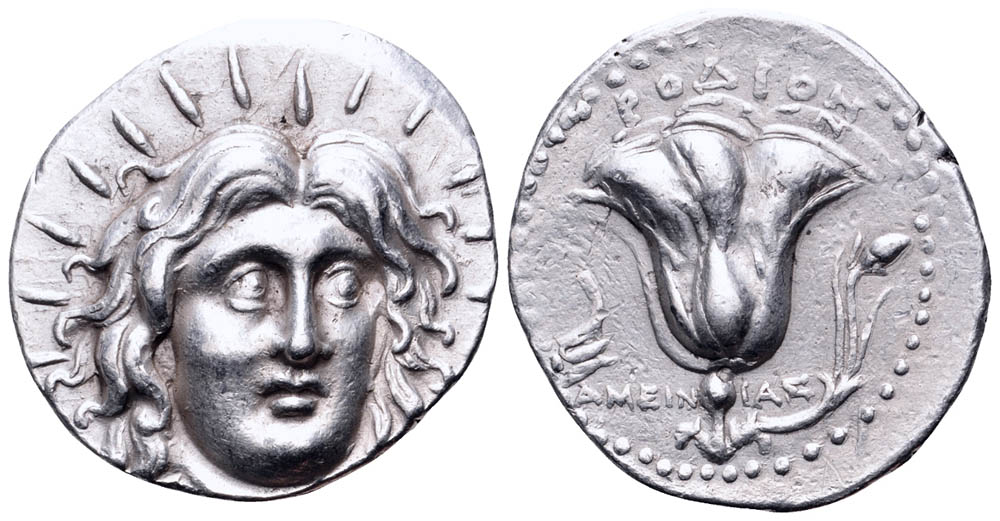225 BCE - 200 BCE | AΛΕΞANΔΡΟΥ
|
|
Sale(s)Sale(s) ᵖ:
|
Classical Numismatic Group 108 (16/05/2018), no. 190; Classical Numismatic Group MBS 57 (04/04/2001), no. 207.
|
|
|
|
Description
| ObverseInscription or printing placed on the obverse.:
|
Head of Herakles right, wearing lion skin headdress. Border of dots.
|
ReverseInscription or printing placed on the reverse.:
|
AΛΕΞANΔΡΟΥ (Greek) Zeus enthroned left, holding eagle and scepter. In left field, monogram (ΜΓ). At the exergue, meander.
|
Mint and issuing power
Chronology
| FromIdentifies the initial date in a range assigned in a numismatic context. 225 BCE toIdentifies the final date in a range assigned in a numismatic context.. 200 BCE
|
Hellenistic 323-30 BC  periodTime period of the numismatic object. periodTime period of the numismatic object.
|
Physical description
MetalThe physical material (usually metal) from which an object is made.: Silver 
|
WeightWeight of the numismatic object (in grams). in grams: 16.9216.92 g <br />16,920 mg <br />
|
DenominationTerm indicating the value of a numismatic object. Examples: tetradrachm, chalkous, denarius.: tetradrachm 
|
|
|
|
StandardStandard.: Attic
|
References
Description
| ObverseInscription or printing placed on the obverse.:
|
Radiate head of Helios facing slightly right
|
ReverseInscription or printing placed on the reverse.:
|
ΡΟΔΙΟΝ (Greek) Rose with bud to right, AMEIN-IAΣ across field, prow in left field
|
Mint and issuing power
| MintIdentifies the place of manufacture or issue of a numismatic object. ᵖ:
|
Rhodes
|
Ancient regionAncient region. ᵖ
|
Caria (Rhodes)
|
Modern countryModern country: Greece
|
AuthorityIdentifies the authority in whose name (explicitly or implicitly) a numismatic object was issued. ᵖ:
|
|
Chronology
| FromIdentifies the initial date in a range assigned in a numismatic context. 230 BCE toIdentifies the final date in a range assigned in a numismatic context.. 205 BCE
|
Hellenistic 323-30 BC  periodTime period of the numismatic object. periodTime period of the numismatic object.
|
Physical description
| DenominationTerm indicating the value of a numismatic object. Examples: tetradrachm, chalkous, denarius. ᵖ:
|
tetradrachm 
|
StandardStandard. ᵖ:
|
Rhodian
|
References
| Frequency of overstrikesFrequency of overstrikes:
|
exceptional
|
Level of confidenceLevel of confidence of the identification:
|
sure
|
| RemarksRemarks:
|
This is a remarkable coin in that it was overstruck on an unlikely undertype, and it also necessitates a total reevaluation of the 3rd century BC civic Alexander coinage at Magnesia. It is clear that this coin was overstruck on a tetradrachm of Rhodes signed by the magistrate Ameinias (Ashton 212); the left portion of the name that is split by the stem of the rose is visible on the reverse, as are portions of the rose and its floral base, above and below the name. What is perplexing is how the Rhodian issue was struck on an Attic weight flan, which is roughly 3-4 grams heavier than the Rhodian standard at that time. Price 2509 is a Rhodian Alexander issue that bears a monogram that R. Ashton thought may resolve to the name Ameinias, and Price thought it possible that the two series, autonomous Rhodian and Alexander type, were struck in parallel. If so, then one could speculate that an Attic standard tetradrachm flan may have been mistakenly struck with dies made for the autonomous Rhodian tetradrachms. However, in his more recent compilation of the Rhodian coinage from 408-190 BC, Ashton placed these coinages in subsequent periods, which would suggest that an unintentional mixing of flans did not occur. In any event, the chronology that Ashton proposes for his series is quite firmly grounded, so his dating of circa 230-205 for the Rhodian civic coinage should be considered for dating the present issue. Price organized the civic Alexanders at Magnesia into logical groups based on hoards as well as a common program of marking. The 3rd century issues are divided into two groups, the earlier characterized by a single monogram in the left field and a maeander pattern in the exergue, while the later group adds a second monogram in the left field. These are dated circa 282-225 BC and circa 225-200 BC, respectively. Having only one monogram, the present coin should fall into the earlier group, especially as there is an issue that has this exact monogram in retrograde (Price 2024). However, this coin is obverse die linked to Price 2046, from the later group. This suggests that the simple arrangement that Price lays out for the 3rd century should be revised, with the present issue being clearly late in the century, since the Rhodian undertype was not struck until circa 230 BC at the earliest.
|
References
- ^ Price, Martin Jessop (1991), The Coinage in the Name of Alexander the Great and Philip Arrhidaeus: a British Museum Catalogue, 2 vol., Zürich-London, 637 p., 637 p., clix pl.
- ^ Ashton, Richard (2001), "The coinage of Rhodes 408-c.190 BC", in Andrew Meadows and Kirsty Shipton (eds.), Money and its uses in the ancient world, Oxford, Oxford University Press, p. 79-115.

